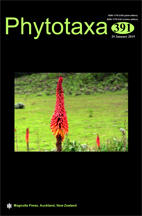Abstract
A new species of a hyphomycetous fungus, Hermatomyces trangensis, was collected during an investigation of the diversity of palm fungi in Na Yong district, Trang province, Southern Thailand, and is introduced in this paper based on morphological and molecular evidence. The fungus is characterized by the production of only one type of conidia, globose or subglobose in front view, broadly ellipsoidal or oblong in lateral view, with dark brown to black central cells and subhyaline to pale brown peripheral cells and sporulation in culture. Phylogenetic analyses of combined SSU rDNA, LSU rDNA, ITS rDNA, TEF1 and RPB2 sequence data using maximum parsimony, maximum likelihood and Bayesian inference approaches placed the fungus within a strongly supported clade with other Hermatomyces species within the family Hermatomycetaceae (Pleosporales, Dothideomycetes). Morphologically, it is similar to other taxa with only one type of conidia such as H. sphaericus, H. sphaericoides and H. verrucosus but molecular data clearly support H. trangensis as distinct from those species.

